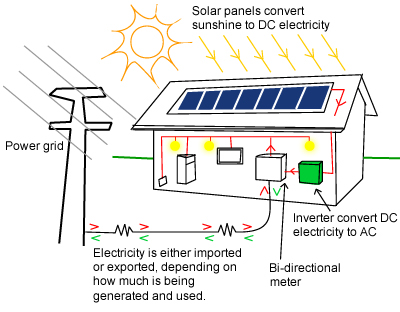
The sun is the greatest source of energy in our solar system, throwing out heat and light in huge quantities across vast distances to reach us here on Earth. Find out how solar panels work to harness it.

The sun is the greatest source of energy in our solar system, throwing out heat and light in huge quantities across vast distances to reach us here on Earth. Harnessing that energy produces no ongoing emissions, and is as close to an inexhaustible power source as we’re likely to encounter. It’s literally easily-converted energy falling out of the sky; all we need to do is hold out the right kind of bucket.
How do solar photovoltaic cells work?
Light’s transmitted as both a wave and a kind of particle – this ‘particle’ aspect of light is known as a photon, and for all intents and purposes it’s a packet of energy – and the aspect of light that solar cells translate into electricity. If you’re not familiar with the physics behind how light works, it’s an amazing thing to think and learn about – although that’s a lesson for a different article!
A typical, basic silicon solar cell consists of a positively charged and a negatively charged layer of silicon. When a photon from the sun hits the negatively charged layer, it excites and knocks loose an electron, allowing it to pass through to the positive side. This creates a ‘hole’ on the positively charged side of the solar cell, which pulls down another electron (and so on), causing a flow of electrons. This flow of electrons is guided through a metal base or wire, and is channelled out of the solar panel with the energy from the other cells in the panel, through to a DC to AC inverter.
The current that’s generated using solar panels is direct current (DC), meaning that there’s a flow of electrons moving in a single direction. For safety reasons, electricity used around the home is supplied as an alternating current (AC) – which works by rapidly oscillating the current back and forth. In order to make use of the current from your solar panels, it needs to be converted to AC, and this is what the inverter’s for. The inverter accomplishes this by introducing a waveform to the current, similar to that used in the power grid. Some power is lost during this conversion, but enough remains to make a considerable contribution to energy generation.
How do I maximise my solar power generation?
To ensure that you’re getting the maximum benefit from your solar panels, here are some handy tips.
- Face the panels as close to true north as possible. In Australia, the sun predominantly comes at us from a northerly direction. Facing your panels north will ensure they get the maximum exposure to light (and therefore photons) as it passes overhead from east to west.
- Tilt the panels to 32º. This is the optimal position for maximum sun exposure. Your panels will work to between 80-90% efficiency at anywhere from a 20º-40º tilt, but there is a very narrow band which can achieve almost 100% efficiency that sits at exactly 32º. Solar panels work best when the sunlight bounces off them at 90º, so having the correct tilt to achieve this for most of the day will generate the most power.
- Keep them free from obstruction to sunlight as far as possible. Shade means light cannot get to the surface of the panel, reducing its operating time for as long as the obstruction remains. Shade can come from a nearby tree, a chimney or aerial or even a neighbouring building. If you really can’t remove the obstruction, then position your panels in a way that blockage from the sun is minimised.
- Keep your panels clean. It will take quite some time for dirt to build up to the point where it can seriously affect your panel’s ability to absorb light, but don’t forget about it either. Once every 6-12 months should be sufficient in most climates. Beware of mould growth though; if your panels retain a little water along the base, mould can take hold there, blocking light to the panels and reducing efficiency.





